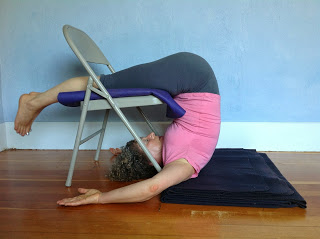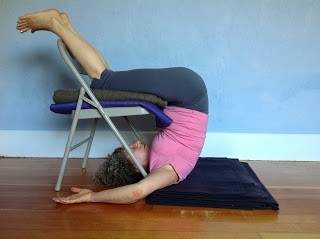by Nina

In her interview with us (see Judith Lasater on Yoga and Aging), Judith Lasater mentioned the poses that she currently practices, citing “especially Viparita Karanai (Legs Up the Wall pose), Supported Sarvangasana (Shoulderstand) on the chair and Supported Halasana (Plow pose) on the Halasana bench.” In my post Judith Lasater’s Favorite Poses, I talked about these poses and why, even though they may be a little tricky to learn, they’re so worth the effort. Today, at long last, I’ll actually get into the nitty gritty details of how to get into and out of Supported Halasana, which Judith does with the Halasana bench.
If you don’t have a Halasana bench (very few of us do!), you need a chair that has no bar between the two front legs because you need to be able to get your head underneath the chair seat. And you also need a chair that either has no back panel or that has a space between the panel and the seat that is large enough to fit your legs through (I’m on the small side, so I use a chair that still has a back panel).
Start by placing two folded blankets (folded as if for Shoulderstand) with the folded ends against the chair legs. Place a folded yoga mat on the chair seat for cushioning. Then lie down on your back, with your shoulders a couple of inches from the folded edges of the blankets (your shoulders will move toward the edge of the blanket when you go up), your head underneath the chair seat, and your knees bent with the soles of your feet on the floor. Lengthen your arms along the floor, with your fingers reaching toward your toes.

To come up into the pose, press your hands into the floor and swing your legs up and onto the chair seat. Scoot your legs through the chair back until your thighs rest comfortably on the chair seat. If necessary, you can steady the chair as you scoot your legs through the chair back by taking your hands onto the front chair legs. When you are settled, bring your arms up toward the chair seat, bend your elbows, and rest your arms on the floor outside of the chair legs.

(With the Halasana bench, there is no chair back to worry about so it is easier to get in the pose, however, the bench has sides so your head is closed in by the box.)
Make sure that your thighs are relaxing onto the chair seat, and that
your back is near vertical (it can be slightly rounded). If you are
tall, you may need to add some height to the chair seat to support your
thighs (that will mean getting out of the pose, adding blankets on top
of the chair seat. This photo shows a second way to do the pose, with extra height on the seat (for a tall person) and bent knees:

Congratulations you’ve made it into a Supported Halasana! The pose should be quite comfortable. Ideally you should be able to remain in the pose for several minutes (I stay about four) to allow the relaxation response to take full effect. Hanging upside down from your hips will also provide a lovely release of your back, as your spine lengthens with gravity. However, if the pose is uncomfortable or causes you any pain, come out of it. Think about what kind of changes you might make to your propping. If you find that you just can’t get comfortable, for example, if your neck is stiff and can’t bend deeply, this pose might not be for you.
To come out of the pose, bring your hands back down by your buttocks. Then press your hands into the floor as you slowly scoot your legs off the chair seat and swing them down, with bent knees, back to the floor.

When your feet are back on the floor, slide out from under the chair so your head is on the blanket stack and your shoulders are resting on the floor. Then slowly roll over onto your side and rest there for a couple of breaths. When you’re ready, slowly use your hands to push yourself up to a seated position, only raising your head when you are fully upright. Taking your time coming out of the pose helps you retain the quietness you cultivated while you were in the pose.
Follow Yoga for Healthy Aging on Facebook ° To order Yoga for Healthy Aging: A Guide to Lifelong Well-Being, go to Amazon, Shambhala, Indie Bound or your local bookstore.


Thanks so much for posting the "how-to's" of the poses Judith Lasater talked about in your interview with her. I was so excited to see your explanation and photos. Thanks for taking the time to get those out…excited to try them!!